Diastasis recti breathing exercises are simple yet powerful techniques that can strengthen your core muscles and reduce abdominal separation.
In this post, you will learn the five best diastasis recti breathing exercises, as well as the benefits of doing them.
Let’s get started!
Key Takeaways/ Quick Summary
- Diastasis recti is a medical condition characterized by an abdominal separation of the right and left sides of the rectus abdominis muscle.
- Breathing exercises can help strengthen the abdominal muscles and reduce your separation by teaching you how to engage your deep core muscles properly.
- The five best diastasis recti breathing exercises are diaphragmatic breathing, posterior pelvic tilt breaths, modified side plank breaths, cat to cow breaths, and Pallof press.
Do Breathing Exercises Help Improve Diastasis Recti?
Yes! Believe it or not, using specific breathing techniques while exercising can help improve diastasis recti by teaching you how to properly engage your deep core muscles. [1]
While many traditional abdominal exercises are too strenuous for women with diastasis recti, breathing exercises can offer a gentle yet effective approach to retraining your core.
The idea is to use gentle, rhythmic breaths to strengthen the transverse abdominis, which lie underneath all of your other ab muscles.
The following exercises will help train your entire core safely and effectively!
The Top 5 Diastasis Recti Breathing Exercises
The five best breathing exercises for diastasis are:
- Diaphragmatic Breathing
- Posterior Pelvic Tilt Breaths
- Modified Side Plank Breaths
- Cat to Cow Breaths
- Pallof Press
Each of these movements strengthens the deep abdominal muscles and teaches proper core engagement.
As a bonus, you can also use these exercises to strengthen the pelvic floor muscles by performing Kegel exercises during each exercise.
Diaphragmatic Breathing for Core Strength
The very best place to start is with deep diaphragmatic breathing. Also known as abdominal or belly breathing, this technique encourages you to take a full breath by exclusively using your diaphragm muscle. Doing so will naturally engage your deep core muscles and improve the tone of your transverse abdominis.
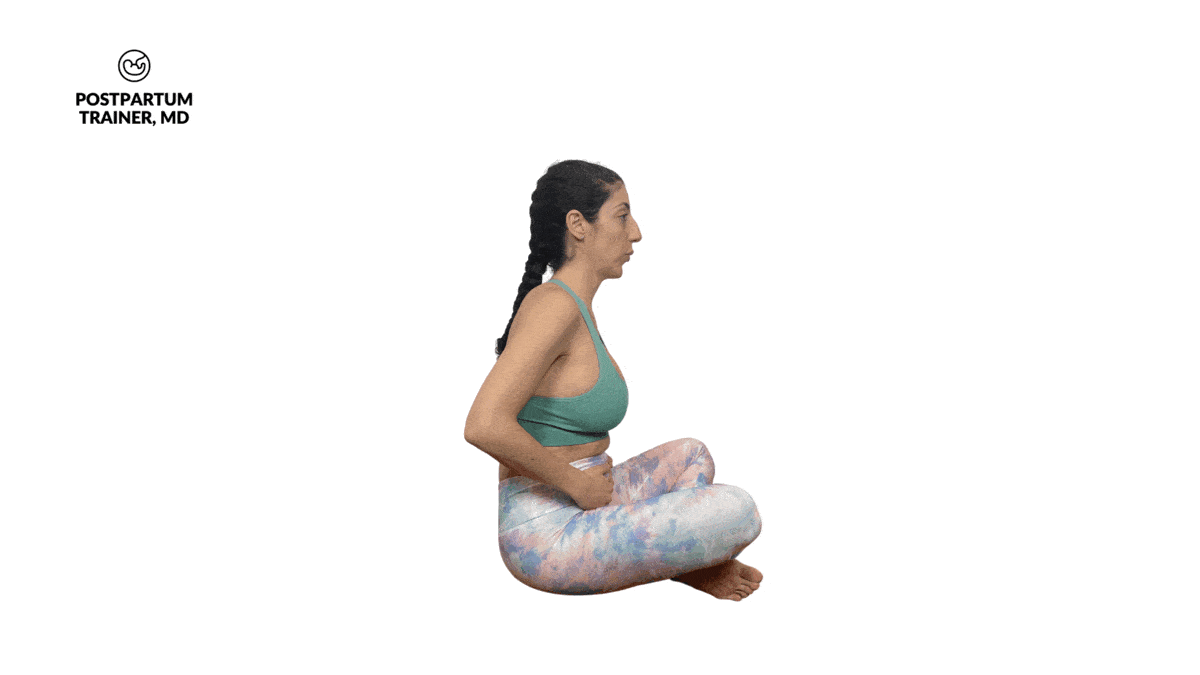
To practice diaphragmatic breathing:
- Sit up straight and place your hands on your abdomen.
- Inhale slowly through your nose, and let your entire abdomen expand in the front and the sides.
- Focus on pushing outwards with your hand as you inhale – this will help you draw the air down into your belly instead of across your chest.
- Hold your breath for a couple of seconds.
- Next, do a slow exhale and actively contract your abdominal muscles inward.
- The outward pressure of the hand helps you focus on getting a full inhale and exhale with each breath.
- Repeat this sequence five times for 2 to 3 sets, making sure to go through the movement slowly.
Mastering Posterior Pelvic Tilt
Next up is my favorite diastasis recti breathing exercise, the posterior pelvic tilt breath. This exercise encourages lumbar neutral posture by increasing tension through the abdominal wall and lengthening the hip flexor muscles.
This exercise will engage your transverse abdominis muscles while teaching your body the correct posture for all your core exercises.
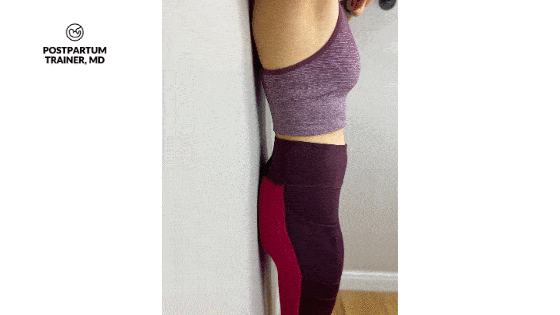
To perform a posterior pelvic tilt:
- Lie on your back with your knees bent and feet flat on the floor.
- There should be a natural arch in your lower back.
- Take a deep breath through your nose, simultaneously inflating your belly and lower back.
- As you exhale, draw your belly and lower back towards each other to tilt your pelvis backward
- Make sure to flatten your lower back against the ground.
- Hold this neutral spine position for a couple of seconds, then release.
- Repeat this sequence five times for 2 to 3 sets, making sure to go through the movement slowly.
- *Note: You can also do this exercise standing, as seen in the picture above*
Modified Side Plank Breathing
Once you have mastered diaphragmatic breathing and posterior pelvic tilting, you can add more challenging breathing exercises like the modified side plank. Side plank positioning is a great way to target the transverse muscles and the obliques.
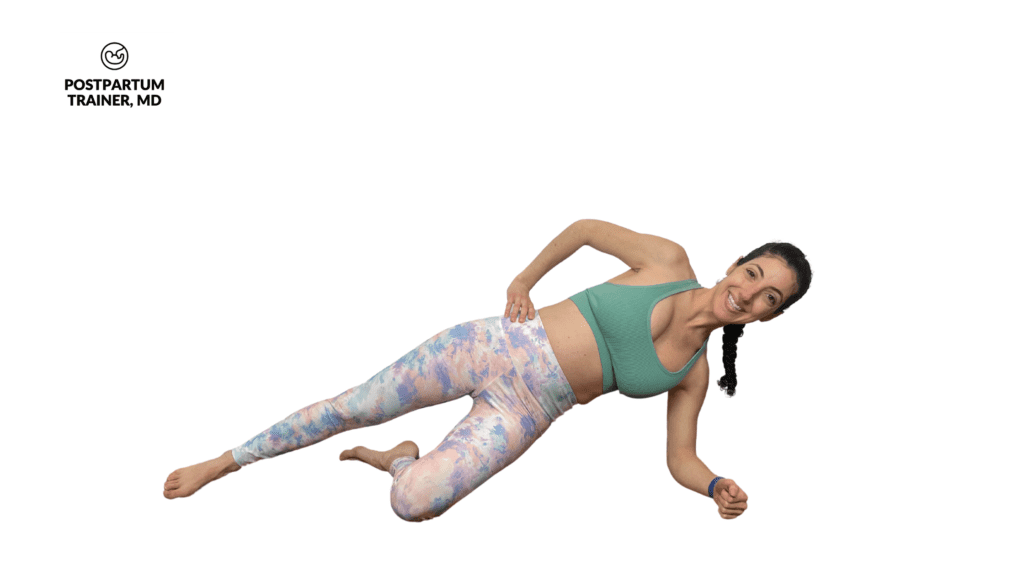
To practice modified side plank breathing:
- Start on your side with your elbow directly underneath your shoulder, and your bottom leg bent at a 90-degree angle.
- Keep your pelvis tucked into a posterior tilt
- Next, lift your hips off the ground, keeping your core engaged and your upper body in a straight line.
- Take a deep breath through your nose, simultaneously engaging both your belly and lower back.
- As you exhale, draw your navel towards the spine and imagine cinching your abdominal muscles closer together.
- Repeat this sequence five times for 2 to 3 sets, making sure to go through the movement slowly
- Hold the modified side plank position throughout the entire exercise, and be sure to train both sides.
- As a bonus, activate the pelvic floor with each breath!
Cat to Cow Breaths
The cat-to-cow breath is a great way to target both the transverse and the rectus abdominis. It is also a great introduction to spinal flexion and extension from a safe position, which is helpful if you suffer from lower back pain.
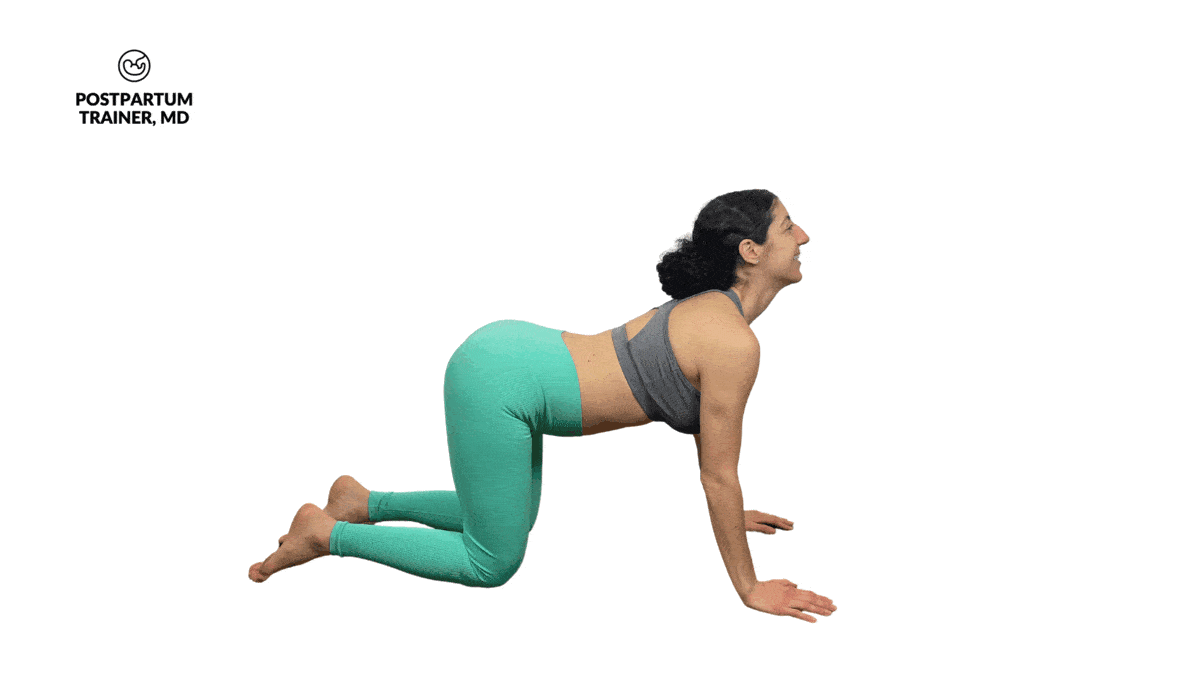
To perform a cat-to-cow breath:
- Begin in a quadruped position (on all fours with your hands directly under the shoulders and knees underneath the hips).
- Inhale through your nose while arching your back and looking up toward the ceiling. Feel your stomach expand and create a concave shape in your spine.
- Hold this position for 1 to 3 seconds.
- Slowly reverse the movement as you exhale, rounding your back as you look towards the floor.
- Draw your belly button toward the spine and feel your core engage as you tilt your pelvis.
- Hold this position for 1 to 3 seconds, then repeat the cycle.
- Repeat this sequence five times for 2 to 3 sets, making sure to go through the movement slowly.
Bonus Exercise: The Pallof Press
The Pallof press is an excellent exercise for strengthening total body core stability. In other words, it helps improve your ability to resist motion. The only thing is, you will need a cable machine or a resistance band to perform the Pallof press.
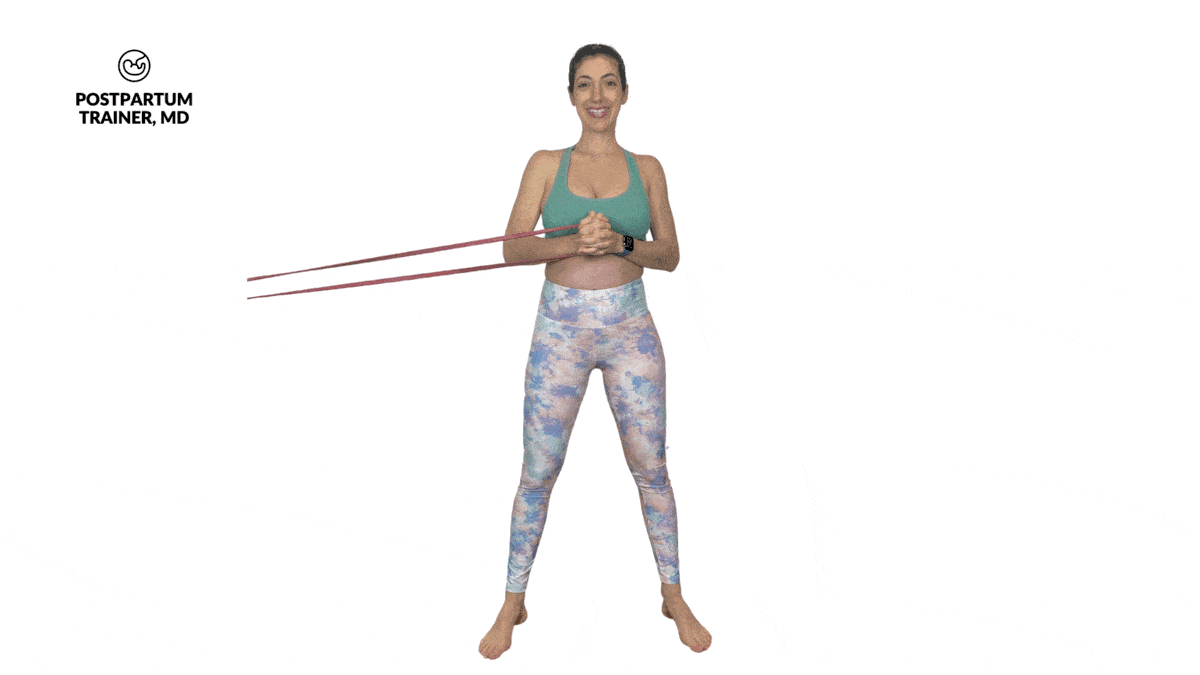
To perform a Pallof press:
- Stand with your feet hip-width apart and the cable machine set at chest height. (Similarly, you can anchor your long closed-loop resistance band to a structure at chest height).
- Grab the cable machine handle or band with both hands in a neutral grip.
- Step away from the cable machine and bring the handle to chest height, keeping your elbows bent.
- Next, turn 90 degrees away from the machine so that your side is facing it.
- Brace your core, keeping the pelvis and lower back in a neutral position.
- Slowly press the handle away from your chest and hold for 3 to 5 seconds as you breathe.
- Return the handle to your chest and repeat this sequence 3 to 5 times on each side.
Activation Techniques to Strengthen Your Abdominal Muscles
Breathing effectively is essential to strengthening your core and improving diastasis recti.
The key is learning to breathe using your diaphragm rather than the accessory breathing muscles like your scalenes, chest wall, and shoulders.
You will know if you are doing the exercises correctly if your belly and rib cage expand and contract without your shoulders moving.
In addition to learning to breathe properly, static core exercises can further strengthen your core muscles and improve posture.
What About The Pelvic Floor?
The pelvic floor is an integral part of core stability and should not be forgotten. Many people neglect this area when it comes to strengthening their abdominals.
Activating the pelvic floor can help improve urinary control and reduce the risk of prolapse.

To learn more, check out my post on The Top 5 Pelvic Floor Exercises For New Moms
These Exercises Are Just The First Step
If you would like a complete list of 100 different exercises you can do to close the gap and strengthen your core, you can find them in my Complete List Of The Best Diastasis Recti Exercises.
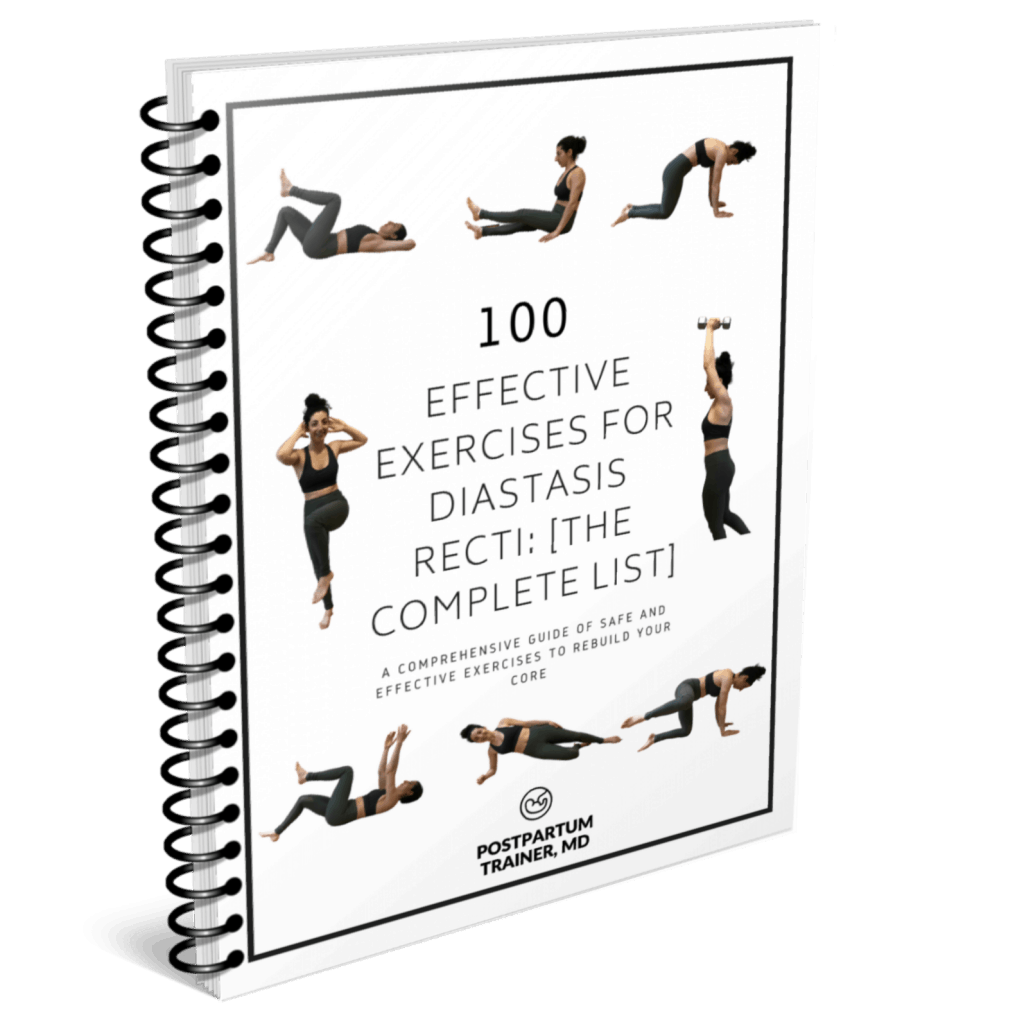
I go over modifications to several exercises like the glute bridge, heel slides, toe taps, and planks to make them safe for your abdominal separation.
What If These Exercises Don’t Help?
If you are doing these core activation exercises and not seeing any improvements, it’s always best to get checked out by a medical professional. They can refer you to a physical therapist or a pelvic floor specialist who can assess your condition and create an individualized treatment plan for you.
Other Related Questions
What is Diastasis Recti?
Diastasis recti is a condition in which the ab muscles (the rectus abdominis) separate or widen along the midline and cause a bulge to appear on the stomach. It is most common among pregnant and postpartum women but can also occur in men.
What Causes The Ab Separation?
Separation of the rectus abdominis muscles is typically caused by excessive intra-abdominal pressure that stretches and weakens the linea alba. (The linea alba is a thin strip of connective tissue that runs down the center of your abdomen and connects the right and left sides of your rectus muscles.) [2]
The most common causes are pregnancy (from the growing baby), excessive body weight, and heavy weight lifting without proper form.
How Do I Know If I Have It?
The best way to diagnose diastasis recti is by performing a modified curl up test.
To do this:
- Lie down on your back with your knees bent and feet flat on the floor.
- Place one or two fingers firmly in the midline of your abdomen, just above the belly button.
- Curl your body up slightly by lifting your head and shoulders off the ground.
- As you do so, gently press against your stomach muscles and see if there is a gap between the left and right abdominal walls.
If so, you may have DR.
I go over this test in more detail in How To Tell If You Have Diastasis Recti.
Get Started On Your Diastasis Recti Recovery
Diastasis recti breathing exercises can have a beneficial effect on your core strength, posture, and overall postpartum recovery.
While these gentle exercises may not be the only solution for healing diastasis recti, they can help build abdominal strength and begin the healing process!
Now I want to hear from you!
Have you ever done these deep breathing exercises?
What was your experience? Share any tips or advice in the comments section below!
Other Related Posts
- How Long Does It Take To Heal Diastasis Recti? (The Honest Truth)
- A Simple Diastasis Recti Workout For New Moms (Just 20 Min)
Get Four Free Workouts To Help Strengthen Your Pelvic Floor & Heal Your Mommy Tummy!

Brittany Robles, MD, MPH, CPT
Brittany Robles is a full-time OBGYN physician, a NASM certified trainer, and a prenatal and postnatal fitness specialist. She holds a Master of Public Health degree in maternal health with a special interest in exercise and nutrition. She is also the co-author of The White Coat Trainer. Learn more about her here.
Sharing is Caring – Send This To A Mom In Need!
References:
1. Laframboise FC, Schlaff RA, Baruth M. Postpartum Exercise Intervention Targeting Diastasis Recti Abdominis. Int J Exerc Sci. 2021 Apr 1;14(3):400-409. PMID: 34055160; PMCID: PMC8136546.
2. Hall H, Sanjaghsaz H. Diastasis Recti Rehabilitation. 2022 Aug 15. In: StatPearls [Internet]. Treasure Island (FL): StatPearls Publishing; 2022 Jan–. PMID: 34424636.
